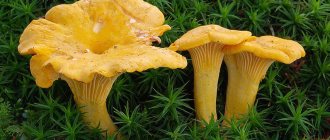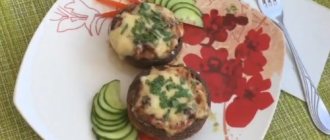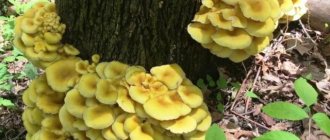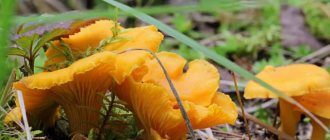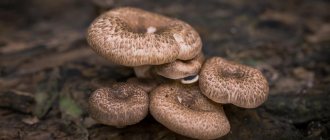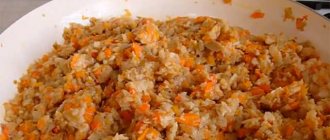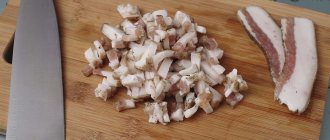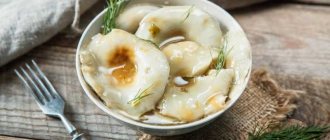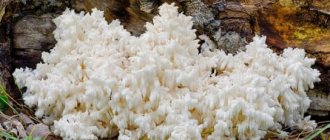The popular edible chanterelle mushroom (Cantharellus tubaeformis) belongs to the chanterelle family and is found by mushroom pickers in well-drained coniferous forests that receive sunlight.
Trumpet chanterelles are charming but not as well known as common chanterelles, which bear fruit earlier. Trumpet chanterelles are favored by the fact that mushrooms appear in hundreds of specimens, and if you find a mycelium, you won’t go home without a harvest.
Description
The fruit body is close in shape to a cap-shaped one, has a tubular structure with a funnel-shaped upper part (“cap”).
The cap is 2-6 cm in diameter, funnel-shaped with a downward curved, often uneven edge. The skin is brown to grayish-yellow, sometimes reddish, with small velvety dark scales.
The pulp is thin and dense, elastic in consistency, white. The taste is weak, mild, sometimes bitter; the smell is weak, pleasant, it is compared to the smell of mirabelle, or earthy.
The stem is tubular; in mature mushrooms, its hole opens in the center of the cap. 3-8 cm high and 0.3-0.8 cm in diameter, cylindrical in shape, often compressed from the sides, chrome-yellow in color, fades to dull yellow with age.
The hymenophore is folded, descending, and consists of sparse branched fragile veins of a yellowish or bluish-gray color.
Spore powder is creamy, spores are 10×8 microns, ellipsoid.
Variability
There are several variations that differ in color, the most common being Cantharellus tubaeformis var. lutescens is brighter yellow.
general characteristics
Chanterelles (lat. Cantharellus
) name several species of mushrooms combined into one genus. Their characteristic feature is that there is no boundary between their caps and legs; they seem to create a single whole. The fruit body is colored in different shades of yellow, orange, and red. The length and thickness of the leg is small, this part is narrowed at the bottom.
The cap is not too large, measuring 2–12 cm in diameter. You can often find specimens in which this part has wavy edges and is irregular in shape. Depending on the type and age, it can be convex or concave. In mature mushrooms it has the shape of a funnel. The top of the cap is smooth and matte.
The pulp is characterized by density and fleshiness . It is white in color with yellow edges. Its taste is sour, its smell is weak, similar to that emitted by dried fruits or roots. If the fruit body is broken and squeezed, the flesh will change color to reddish or bluish.
Under the cap are wavy folds or thick veins. They cover most of the leg.
This mushroom does not have a cover. Chanterelles are common in forests where conifers and deciduous trees grow. They form mycorrhizae with many plants. Most of the representatives of the genus grow on the ground. Some specimens prefer a growing environment such as moss.
Chanterelles
Herbaceous scale
| Latin name: | Cantharēllus cibārius |
| English name: | Chanterelle |
| Domain: | Eukaryotes |
| Kingdom: | Mushrooms |
| Department: | Basidiomycetes |
| Class: | Agaricomycetes |
| Order: | Chanterelles |
| Family: | Chanterelles |
| Genus: | Chanterelle |
| Edibility | Edible mushroom |
general information
The mushrooms got their name because of their characteristic reddish-yellow color. This color is due to the high content of vitamin C.
There are edible and poisonous species of chanterelles. False representatives of this group of fungi grow on rotting trees and are most often found in swamps and near lakes. Edible chanterelles most often grow in coniferous and mixed forests.
This group of fungi belongs to the chanterelle family, class Agaricomycetes.
Mushroom dimensions
The mushroom is small in size, with a long thick stem. The average diameter of the cap is 10 cm, the stem reaches dimensions of 10-13 cm in length and 1-2 cm in width.
hat
Chanterelles have a yellow-orange flat cap. It is wavy at the edges and curled towards the center. If you look at the cap from above, you can see that it is irregular in shape. The top of the chanterelle can be from 1 to 10 cm in diameter. It has a tubular structure.
Pulp
The flesh of chanterelles is dense and white. There are fibrous and fleshy ones. When pressed, it changes color to red. The aroma resembles the smell of dried fruits, and the taste is sour.
Leg
The leg of the chanterelle is usually thick and long. Can reach 15 centimeters in length. It does not have a skirt or ring and, most often, simply grows together with the top. The color is orange-yellow, more saturated at the top. The cap expands from bottom to top and has small scales in the lower part.
Where do chanterelles grow?
The common chanterelle prefers to grow in mixed and coniferous forests. It can be found in places where moss and long plants grow. The season for collecting chanterelles is considered to be mid-summer - late autumn.
For a good harvest, chanterelles need a lot of moisture and nutrients, which enter their bodies through moss and wood.
This type of mushroom feels uncomfortable in deciduous forests. Under a large layer of fallen leaves, sunlight does not penetrate well, which is why the mushrooms begin to dry out and lose their attractive appearance.
Coniferous and mixed forests are the optimal habitat for chanterelles. The soil under pine and spruce contains many microelements that promote the development of mycelium. It is in such places that the root of the mushroom can produce several fruits in one season.
Chanterelles are found all over the world, with the exception of permafrost and deserts.
When do chanterelles appear?
The optimal time for chanterelle growth is July-September. The mycelium begins to bear fruit best in August after warm summer rain. This group of mushrooms does not tolerate cold, so they do not grow in winter.
In addition, chanterelles do not like the hot sun, so in spring and early summer they slow down their growth. The same stop in the development of mycelium occurs after each summer rain - the fungus tries to retain moisture for a long period of time. The fruit resumes its development on the third to fifth day after watering.
Edibility
There are both edible and inedible types of chanterelles. The common chanterelle has a pleasant smell and a delicate hue, and the false mushroom smells like fish or vinegar.
The main differences between edible chanterelles and inedible ones are:
- Hat color. Inedible chanterelles are bright orange, while edible ones are yellow.
- Hat shape. Inedible mushrooms have a clear circle shape.
- Leg. A real mushroom has a thick stalk, while an inedible mushroom has a thin stalk.
- Smell. Inedible representatives of chanterelles have a vinegary odor.
- Habitat. Inedible chanterelles grow on fallen trees in deciduous forests, while real ones grow in mixed or coniferous forests.
- Pulp. Edible chanterelles have yellow flesh with white flesh in the center. Fake mushrooms have orange flesh.
If the mushrooms are real, then they can be fried, boiled or baked. Chanterelles make good casseroles, pies, zrazy and soups. All these dishes will not take more than an hour of preparation. Chanterelles can also be salted, pickled or dried, but this will take more time.
There are many types of chanterelles. You need to be able to distinguish edible representatives from inedible ones.
The fox is real
This type of mushroom is found in deciduous and coniferous forests. It can be found from early summer to mid-autumn. A special feature of the mushroom is its bright yellow color.
The hat of a real chanterelle has a hole in the center and curled edges. Yellow color. The diameter can reach 10 cm. The leg is attached to the cap in one layer and does not have a skirt. Its dimensions are 3-10 cm, and its shape is cylindrical. The pulp is dense and difficult to damage by larvae and flies. Chanterelle spore powder is yellow in color.
Application
In cooking
The tubular type is used in all dishes like the common chanterelle. Due to the slight hardness of the pulp, it requires longer boiling time. The mushroom is dried, used as a component of soups, main courses, sauces, filling for pies, salted and pickled for the winter, and mushroom powder is made from it.
In medicine
The mushroom is not included in the State Pharmacopoeia of Russia; it is used in non-traditional treatment. In China and Japan, drugs are produced in the form of capsules with chanterelle powder with anthelmintic action. In Western European medicine, an extract from these mushrooms is used in the treatment of hepatitis C and to cleanse the liver.
Tube Chanterelle, Cantharellus tubaeformis
Hat:
It is medium-sized, smooth or convex in young mushrooms, with age it acquires a more or less funnel-shaped shape and becomes elongated, which gives the entire mushroom a certain tube-like appearance; diameter - 1-4 cm, in rare cases up to 6 cm. The edges of the cap are strongly turned up, the surface is slightly irregular, covered with discreet fibers, slightly darker than the dull yellowish-brown surface. The cap flesh is relatively thin, elastic, with a pleasant mushroom taste and smell.
Hymenophore:
The spore-bearing layer of the tube-shaped chanterelle is “false plates” that look like a branched network of vein-like folds descending from the inside of the cap onto the stalk. Color – light gray, discreet.
Spore powder:
Light, grayish or yellowish.
Leg:
Height 3-6 cm, thickness 0.3-0.8 cm, cylindrical, smoothly turning into a cap, yellowish or light brown, hollow.
Spreading:
The mushroom is a common one, but it is not found in our area very often. It is difficult to say what is the reason for this, its general inconspicuousness, or whether Cantharellus tubaeformis is really becoming rare. In theory, the tube-shaped chanterelle forms a hymenophore with coniferous trees (simply spruce) in damp mossy forests, where it bears fruit in large groups in September and early October.
Similar species:
The yellowing chanterelle, Cantharellus lutesens, is also noted, which, unlike the tube-shaped chanterelle, is devoid of even false plates, shining with an almost smooth hymenophore. It is even more difficult to confuse the tube chanterelle with other mushrooms.
Edibility:
It is equivalent to the real chanterelle, Cantharellus cibarius, although it will hardly bring so much joy to the gastronome, and the esthete will not soon get bored to the same degree. Like all chanterelles, it is consumed mainly fresh, does not require preparatory procedures such as boiling, and also, according to writers, is not full of worms.
Author's notes:
The tube-shaped chanterelle is an exposure for the entire genus of chanterelles, which has decided to penetrate the family of real agaric mushrooms. From all this one can see some kind of negligence, haste, and lack of preparation. The mushroom seems to have grown plates of itself - but from the very first glance it is clear that they are not real. The veins are somehow intertwined, insincere. And, if I may say so, “hat”? It can be seen with the naked eye that some semblance of a hat was hastily made from a “single mushroom-funnel”, into which the tube-shaped fox strives to turn at every opportunity, putting its curator in a very awkward position. In general, the second attempt - after the real, yellow and bright chanterelle - to infiltrate undercover completely failed. That’s why, probably, you won’t find this mushroom anywhere except in special places, which few people know about either.
The plates indicate that they are chanterelles with heads. Of course, the tube-shaped chanterelle, especially in its youth, can be mistaken for some kind of lamellar mushroom. But this refers, rather, to the inexhaustible possibilities of man. Because for a person of ordinary ability, it is enough to look at the branching, sinewy folds on the underside of the hat and authoritatively conclude that this is clearly some kind of fox. Possibly Cantharellus tubaeformis
.
Tubular Chanterelle (Craterellus tubaeformis)
Other names:
Tubular chanterelle (lat. Cantharellus tubaeformis) is a mushroom of the chanterelle family (Cantharellaceae).
Cap: Small, smooth or convex in young mushrooms, with age it acquires a more or less funnel-shaped shape, elongates, which gives the whole mushroom a certain tube-like appearance; diameter - 1-4 cm, in rare cases up to 6 cm. The edges of the cap are strongly turned up, the surface is slightly irregular, covered with discreet fibers, slightly darker than the dull yellowish-brown surface. The cap flesh is relatively thin, elastic, with a pleasant mushroom taste and smell.
Laminae: The chanterelle's hymenophore is a “false laminae” that looks like a branched network of vein-like folds descending from the inside of the cap onto the stalk. Color - light gray, discreet.
Spore powder: Light, grayish or yellowish.
Leg: Height 3-6 cm, thickness 0.3-0.8 cm, cylindrical, smoothly turning into a cap, yellowish or light brown, hollow.
Distribution: The period of abundant fruiting begins at the end of August and continues until the end of October. This mushroom prefers to live in mixed and coniferous forests, in large groups (colonies). Feels good on acidic soils in the forest. The trumpet chanterelle is not found in our area very often. It is difficult to say what is the reason for this, its general inconspicuousness, or whether Cantharellus tubaeformis is really becoming rare. In theory, the tube-shaped chanterelle forms a hymenophore with coniferous trees (simply spruce) in damp mossy forests, where it bears fruit in large groups in September and early October.
Similar species: The yellowing chanterelle (Cantharellus lutescens) is also noted, which, unlike the tube-shaped chanterelle, is devoid of even false plates, shining with an almost smooth hymenophore. It is even more difficult to confuse the tube chanterelle with other mushrooms.
- Cantharellus cinereus is an edible gray chanterelle, distinguished by its hollow fruiting body, grey-black color and lack of ribs at the bottom.
- Common chanterelle. It is a close relative of the funnel-shaped chanterelles, but differs in that it has a longer fruiting period (unlike the funnel-shaped chanterelle, which bears abundant fruit only in the fall).
Edibility: Equated to the real chanterelle (Cantharellus cibarius), although it will hardly bring so much joy to the gastronome, and the esthete will not soon get bored to the same degree. Like all chanterelles, it is consumed mainly fresh, does not require preparatory procedures such as boiling, and also, according to writers, is not full of worms. It has yellowish flesh and an inexpressive taste when raw. The smell of raw funnel-shaped chanterelles is also inexpressive. Can be pickled, fried and boiled.
Notes: The tube-shaped chanterelle is an exposure for the entire genus of chanterelles, which has decided to penetrate the family of real agaric mushrooms. From all this one can see some kind of negligence, haste, and lack of preparation. The mushroom seems to have grown plates of itself - but from the very first glance it is clear that they are not real. The veins are somehow intertwined, insincere. And, if I may say so, “hat”? It can be seen with the naked eye that some kind of cap was hastily made from a “single mushroom-funnel”, into which the tube-shaped chanterelle strives to turn at every opportunity, putting its curator in a very awkward position. In general, the second - after the real, yellow and bright fox - attempt to infiltrate undercover completely failed. That’s why, probably, you won’t find this mushroom anywhere except in special places, which few people know about either.
Photo of mushroom Chanterelle tubular
from questions in recognition:
LAT
Characteristics:
| Group: | Lamellar |
| Records: | Light gray shades |
| Color: | Orange, brown and brown |
| Info: | Easily broken |
Taxonomy:
| Department: | Basidiomycota (Basidiomycetes) |
| Sub-department: | Agaricomycotina (Agaricomycetes) |
| Class: | Agaricomycetes (Agaricomycetes) |
| Subclass: | Incertae sedis (uncertain position) |
| Order: | Cantharellales (Cantharellales) |
| Family: | Cantharellaceae (chanterelles) |
| Genus: | Craterellus |
| View: | Craterellus tubaeformis (Tubular chanterelle) |
Edible mushroom (category 4)
Mushroom picking time
Chanterelles can be found already at the beginning of summer, but mostly they are found alone. Their season starts in July. Mushrooms love warmth and moisture, so when rainy weather gives way to warm and sunny weather, it’s time to go to the forest to collect the harvest. This climate in Russia is observed from the beginning of July until October.
Chanterelles never cease to amaze not only with their beneficial properties, but also with their characteristics. They do not rot in wet weather, and in dry weather they do not dry out, but stop growing. When pressed, they do not change color or texture, so they can be safely collected in large baskets and transported.
Trumpet chanterelle
The popular edible chanterelle mushroom (Cantharellus tubaeformis) belongs to the chanterelle family and is found by mushroom pickers in well-drained coniferous forests that receive sunlight.
p, blockquote 1,0,0,0,0 –>
Trumpet chanterelles are charming but not as well known as common chanterelles, which bear fruit earlier. Trumpet chanterelles are favored by the fact that mushrooms appear in hundreds of specimens, and if you find a mycelium, you won’t go home without a harvest.
p, blockquote 2,0,0,0,0 –>
p, blockquote 3,0,0,0,0 –>
Where do trumpet chanterelles grow?
Trumpet chanterelles are common in spruce forests on acidic soil and bear fruit in colonies. In mainland Europe, the mushroom is more common in northern latitudes; in countries located closer to the south, trumpet chanterelles grow on forested hills.
p, blockquote 4,0,0,0,0 –>
Once you find a forest with Cantharellus tubaeformis, it will not be difficult to collect mushrooms for food. Thanks to their delicate taste and pleasant firm texture, trumpet chanterelles have won the liking of wild mushroom cooks.
p, blockquote 5,0,1,0,0 –>
Taxonomic history
p, blockquote 6,0,0,0,0 –>
The name Cantharellus tubaeformis was given and described by the Swede Elias Magnus Fries in 1821. In Sweden, a soup is prepared from the mushroom in a pot; the Swedes call the trumpet chanterelle Trattkanterell.
p, blockquote 7,0,0,0,0 –>
The generic name Cantharellus comes from the Latin word cantharus - a vessel, bowl or drinking cup with handles. The word tubaeformis means "hollow tube shape".
p, blockquote 8,0,0,0,0 –>
Appearance
hat
p, blockquote 9,0,0,0,0 –>
From 2 to 5 cm in diameter, thin flesh, brown above with a pale edge, streaked below, funnel-shaped, with a wavy edge.
p, blockquote 10,1,0,0,0 –>
p, blockquote 11,0,0,0,0 –>
Veins
p, blockquote 12,0,0,0,0 –>
Initially yellow, they become grayish as they mature, with wrinkled veins branching out and straightening out. There are also cross veins under the cap.
p, blockquote 13,0,0,0,0 –>
Leg
p, blockquote 14,0,0,0,0 –>
Tall, somewhat flattened and hollow, 5 to 10 mm in diameter and often slightly clubbed or convex at the base. The smell/taste is not distinctive.
p, blockquote 15,0,0,1,0 –>
Habitat and ecological role
Trumpet chanterelles are often found among ivy from September to November in coniferous forests in humid weather conditions.
p, blockquote 16,0,0,0,0 –>
p, blockquote 17,0,0,0,0 –>
Use in cooking
Tubular chanterelles are dried over a radiator or in a warm oven with the door open, and stored in airtight jars for later use in culinary recipes.
p, blockquote 18,0,0,0,0 –>
p, blockquote 19,0,0,0,0 –>
Benefit for health
If there is not enough vitamin D, the tube chanterelle will fill the deficiency. The fruiting bodies of the mushroom are considered healing in folk medicine. Healers prescribe dishes with mushrooms to people who suffer from eye diseases, skin diseases or poor hair condition. Frequent consumption of chanterelles in winter increases the body's resistance to viruses.
p, blockquote 20,0,0,0,0 –>
Trumpet chanterelle look-alikes
The trumpet chanterelle has no clearly defined false analogues. If the rules for collecting and identifying the species are followed, there is no chance of harvesting a poisonous crop. The tube-shaped chanterelle resembles the common chanterelle, but it is bright yellow, the cap is larger in diameter and more squat, the leg is hard, the flesh is pale with a slight fruity (apricot) smell.
Cooking recipes
Chanterelles are considered valuable mushrooms. During the cooking process they acquire a noble nutty taste. They practically do not change their color, turning a little brown in the marinade. Cooking trumpet chanterelle is a pleasure!
Primary processing
Collect only young specimens without significant defects from the forest. It is better to place small fruits on top of the basket so that larger mushrooms do not crush them.
How to properly clean chanterelles:
- When going mushroom hunting, be sure to take a pocket knife with you. It is useful not only for collecting fruits: it is used to clean dirt on chanterelles right in the forest.
- When you come home, remove the blades of grass from the caps and myceliums.
- Rinse and use for cooking.
Cooking
To quickly begin the main preparation of mushrooms, you need to first boil them and drain the water. There is a second way to remove bitterness, but it will take longer - soak the fruits for 4-5 hours in cold water.
- 1 kg chanterelles;
- 0.5 tsp. salt;
- 5 black peppercorns;
- clove of garlic.
- Cut the mushrooms into pieces.
- Place the chanterelles in a saucepan and cover with cold water.
- Add all the seasonings there.
- When the water boils, set aside 15–20 minutes.
- Drain the liquid through a colander.
Pickling
Before marinating, you need to boil the chanterelles for 20 minutes. Drain the liquid and put the pan of water back on the fire. When the liquid boils, lower the fruiting bodies into boiling water.
- 1 kg chanterelles;
- 1 liter of water;
- 0.5 tsp. granulated sugar;
- 0.5 tsp. salt;
- 1 bay leaf;
- 5–6 clove inflorescences;
- 3 black peppercorns;
- 1 tbsp. l. 9% vinegar.
How to pickle chanterelles:
- When the fruiting bodies are already in boiling water, add all the spices (except vinegar). Boil the marinade for 5 minutes.
- Pour a tablespoon of vinegar into the pan and turn off the gas.
- Pour into clean jars.
- Roll up. Store in a cool, dark place.
Freezing
Please note that chanterelles should not be washed before freezing. Further actions:
- Clean the mushrooms with a knife and dry cloths to remove any dirt.
- Cut into thin slices.
- Place on a tray and place in the freezer for 4 hours.
- Take out the workpiece and distribute it into bags.
- Store chanterelles in the freezer.
Frying
Before frying the mushrooms, soak them in cold water for 4 hours, then start cooking.
- 1 onion;
- 500 g chanterelles;
- 0.5 tsp. salt;
- ground black pepper (to taste);
- 3 tbsp. l. sunflower oil.
- After soaking, dry the fruiting bodies with a dry cloth.
- Cut the onion and chanterelles into strips.
- Heat a frying pan with sunflower oil. Put all the ingredients in it.
- Fry over high heat until golden brown.
- Cover the pan with a lid. Simmer until done (about 10 minutes).
Pickling
Tubular mushrooms are the best material for sowing. Choose exclusively young and elastic mushrooms of small size. Overgrown specimens become flabby during cooking and do not crisp.
Preparing chanterelles for salting:
- Process the fruits.
- Make a solution in a bowl: dilute 10 g of salt and 2 g of citric acid in 2 liters of water. Pour in the mushrooms and leave them in the container for 5 hours.
- After soaking, boil the chanterelles twice to remove the bitterness. The first time, fill them with cold water, bring to a boil, and drain the liquid. The second time - put it in boiling water and boil for 20 minutes.
Cold pickling helps preserve mushrooms and enjoy them all winter long. It is important that the jars with the preparations are in a cool place.
- 1 kg of mushrooms;
- 80 g salt;
- 3 tbsp. l. vegetable oil;
- 5 dill umbrellas;
- 2 heads of garlic.
- If you don’t want to waste time on cooking, you can simply scald the peeled chanterelles with boiling water.
- Place a sprig of dill and a little garlic in the jar.
- Place the mushrooms in layers and add salt.
- Place the remaining garlic and dill on top.
- Press down the workpiece with pressure and place it in a cool place for 24 hours.
- Pour sunflower oil over the cold-seasoned chanterelles and cover tightly with a lid.
Read also: Salting salmon at home in large pieces
Salted mushroom is ideal for making soups, salads, and filling for pies.
- 1 kg chanterelles;
- 6 cloves of garlic;
- 5 pieces. bay leaves;
- 3 pcs. carnations;
- 5 tsp. coarse salt;
- 10 black peppercorns (you can use allspice).
- Place a pinch of salt, spices (except garlic), and mushrooms in a large saucepan. Fill with water.
- Place over medium heat, cook for 15–20 minutes.
- During the cooking process, foam will form. Remove it with a slotted spoon.
- Place the boiled mushrooms (along with the brine) in sterile jars. It is important that the chanterelles are completely covered with liquid.
- Place a weight on top and put the workpiece in a cool place.
- After a day, pickled mushrooms can be eaten. If you are going to store them in winter, you can roll them up with a sterile lid.
Helpful advice! To ensure that the pickling is ready as quickly as possible, the mushrooms are cut into small pieces.
Oven drying
It is most convenient to dry chanterelles using the oven. This way you will provide yourself with delicious food for a whole 12 months.
- Clean the mushrooms from dirt using a dry method.
- Cut the chanterelles into slices.
- Cover a baking sheet with parchment, place the pieces on top (they should not touch each other, they should be dried at a distance of 1-2 cm).
- Preheat the oven to 50°C and place a baking tray. Leave the door ajar.
- After 1.5 hours, increase the temperature to 60 °C.
- After 60 minutes, remove the baking sheet and check the readiness of the fruiting bodies with a fork. Dried mushroom should be plastic and dry.
- Ready chanterelles can be removed from the oven and poured into clean glass jars for storage.
Attention! Cooking time can vary within 15–20 minutes. The thinner you cut the slices, the faster they dry.
Canning for the winter
Having prepared forest fruits for future use, you will be able to brighten up your winter dinner with aromatic mushrooms. We recommend cooking chanterelles in lemon juice in Finnish style.
- 2 kg of mushrooms;
- 1 liter of water;
- 70 g salt;
- 150 g sugar;
- 7 pcs. carnation;
- 10 peas of black or allspice;
- 9 tbsp. l. lemon juice.
The Finnish recipe consists of the following steps:
- Rinse the chanterelles well and cover with water.
- Bring to a boil, boil the mushrooms for about 15 minutes. Drain the liquid.
- Prepare a brine from water, sugar, pepper, cloves, and salt. When it boils, add the chanterelles and cook for 10 minutes.
- Pour in lemon juice and stir the contents of the pan well. Simmer the mushrooms over low heat for 5-7 minutes.
- Remove the container from the heat and place the ingredients into jars. After rolling, place the workpiece with the lids down. When the contents have cooled, you need to put the preservation in a dark place.
- Chanterelles are ready to eat a month after preparation.
Prepare chanterelles canned in tomato - this delicious appetizer will delight not only you, but all your guests!
Ingredients:
- 2 kg of mushrooms;
- 1 kg of onion;
- 300 g tomato paste;
- 1 tbsp. water;
- vegetable oil;
- 5 tsp. salt;
- 1 tsp. ground black pepper;
- 1 tsp. garlic, passed through a press;
- 4 bay leaves;
- 3 tbsp. l. vinegar 9%.
- Boil the fruits for 15–20 minutes in water with a pinch of salt.
- Drain the chanterelles through a colander.
- Fry the onion in a frying pan until golden brown.
- Cut the mushrooms into small slices and place in a frying pan.
- Add all the spices (except vinegar), fry over moderate heat for 60 minutes. Before adding tomato paste, dilute it a little with water.
- Stir the mixture occasionally to avoid burning.
- Pour in vinegar. Keep the heat on for another 15 minutes.
- The cans are rolled up by turning them upside down. After the canned food has cooled, move it to a dark, cool room.
Comparison of real and false chanterelles
Every lover of collecting forest gifts should know what a false chanterelle looks like. To determine the differences, it is necessary to familiarize yourself in detail with each type. Varieties of chanterelles such as tubular, gray, white and others do not have doubles, but the common cockerel can be confused with the orange talker.
The fox is real
False fox
Despite the fact that edible and false specimens are very similar, an experienced mushroom picker can easily distinguish them from each other. This is where simple advice from an experienced forest lover comes in handy. Even though these are delicious mushrooms, you should remember that they have doppelgängers. I’ll tell you how I identify chanterelles: you can focus on the color of their caps and the shape of their legs. Thus, everyone’s favorite cockerels are distinguished by their muted reddish color.
The surface of their cap is matte, always smooth, the skin is almost inseparable from the pulp - thick, juicy, matching the shade of the stem. Sometimes the flesh of the mushroom can be very light, almost white. When broken and pressed, it turns slightly red.
The edges of the cap when young are smooth and neatly rounded. As they grow, they curve beautifully, become wavy at the edges, and the fruiting body takes on a slightly funnel-shaped shape with a recessed center.
The real chanterelle is capable of growing to a large size. Often there are specimens with a cap diameter of about 10-12 cm.
Chanterelle mushrooms have a thick and strong stem. It expands at the top and smoothly passes into the cap. The color of the fruiting body does not change throughout its entire length and is uniform. The thickness of the leg is from 10 to 30 mm, the length is up to 7 cm. It is slightly lighter than the cap.
Cockerels do not have plates; the hymenophore consists of frequent, highly branched folds that descend onto the stalk, forming one whole with it.
The color of the false chanterelle's caps is brighter than that of real ones. So, when collecting gifts from the forest, a mushroom picker should be alerted by the yellow or orange, slightly velvety surface of the specimen encountered. The diameter of the cap of the cocoshka does not exceed 6 cm, the plates descend onto the stem. They are frequent, thin, bright. The pulp is white or yellow, with a pungent mushroom odor (if the aroma is sweetish, this also indicates that the specimen belongs to the Hygrophoropsis genus).
The pronounced difference between these mushrooms is that they have a rather thin (up to 10 mm) and long (up to 5 cm) stalk. It is smooth, but can rarely be curved. The inside is fibrous, with pulp resembling cotton wool. The color of the flesh of the stem does not match the shade of the cap; at the base it is darker (almost black).
Key differences
So, you need to remember the difference between the representatives of the two types of eukaryotes. They are the following:
- False chanterelles have a brighter color. Cockerels have a calm reddish tone.
- If the mushroom has a sour taste, and its stem is thick and smoothly turns into a cap, then it is an ordinary chanterelle. This mushroom has a slightly curved stem shape. Kokoshki have a thin and hollow stem.
- The chanterelle mushroom grows in large colonies, while the coco mushroom grows almost always in single specimens. It can be found on fallen and rotting tree trunks.
- All kinds of worms and larvae love to eat false chanterelles, while cockerels are extremely rarely spoiled by insects. The only worm that can be found when cutting the fruiting body of a betta is the wireworm. This fact is explained by the presence of a large amount of chitinmannose in the fruiting bodies of common chanterelles.
- Another difference is that false eukaryotes have an easily removable skin. When it is removed, the rough surface of the cap is exposed. It is almost impossible to remove the skin of cockerels.
- In orange talkers, the color of the plates is brighter than the tone of the cap, while in cockerels it is uniform and the same over the entire surface.
These are the main characteristics that show how one species differs from another.
How to distinguish edible from inedible
Inedible things that grow in nature include:
- False chanterelles (orange talkers), outwardly similar to the trumpet chanterelle. False chanterelles have denser flesh (not as fragile as real ones), their color is defiantly orange, the leg is thin, curved, fibrous inside (in tubular ones it is hollow). False chanterelles grow one by one, tubular chanterelles grow only in colonies; false chanterelles are affected by pests, tubular chanterelles are not. The false chanterelle, unlike the real one, can easily remove the skin from its cap.
- Omphalotus oleifera grows on fallen tree trunks and stumps in tiers, like honey mushrooms. The caps are covered with mucus. The pulp at the break smells unpleasant. In the dark, the records emit a slight glow.
How to treat false chanterelles
Like all mushrooms, it is advisable to soak false chanterelles in salt water before eating. You just have to spend not a couple of hours on this, but a whole day, during which you need to change the water several times. An alternative and more reliable type of preparatory measures would be heat treatment, which can be divided into two main stages: primary and secondary.
Did you know? Every year, about 200 tons of chanterelles are collected in the world, and 72 tons are taken from the forests of Latvia.
To achieve maximum effectiveness of the actions performed, you should follow the following sequence:
- Clear the mushrooms of debris and cut off deformed and darkened areas along with the internal parts of the cap of overripe specimens.
- Rinse the product under running water for a few minutes, then drain in a colander and allow the water to drain.
- Soak the mushrooms for 10 hours, changing the liquid every few hours, and then let them sit for another 10 minutes.
- Cut the product into several parts and boil in salted water for 30 minutes, adding a whole, unpeeled onion to them. All this time, you should periodically remove the foam that appears, and then throw the chanterelles into a colander and rinse with cold water.
- Transfer the prepared mushrooms to salted water and bring to a boil again, leaving on the stove for about 10 minutes.
- Rinse them under running filtered water and place in cheesecloth, allowing the liquid to drain and the mushrooms to cool.
- Scald the already dried mushrooms and rinse them again, placing them in a colander.
For greater confidence in the possibility of consuming these mushrooms, you can additionally hang them over a pan of boiling water for 5 minutes. After this, use standard culinary recipes to prepare the already prepared products.
False doubles
Fortunately, the tube chanterelle does not have poisonous counterparts; even if a similar species gets into the basket by mistake, there will be no poisoning. Similar in appearance are the Yellow Chanterelle and the Gray Funnel. All of them have a funnel-shaped cap. In order not to confuse them, carefully examine the photographs.
Characteristics of different types of chanterelles
| Tube-shaped chanterelle |
Where do they grow, in which forests and how to collect them
Unfortunately, the trumpet fox is not the most frequent visitor to Russian forests, but if the hunter is lucky, he has every chance of stumbling upon not just one funnel, but an entire family, since the species tends to grow in entire colonies. If there is a goal to collect this particular variety, then it is worth choosing conifers and mixed forests with a predominant slightly acidic soil, which is preferred by the mycelium, where, in fact, the slight sourness in the fruit pulp comes from.
It is worth noting that the factor of inconspicuousness also plays an important role in the search for the species, since this fox does not have the same bright colors as the real one, and its miniature size often leads to the fact that it cannot break out onto the surface of the dead wood and densely littered with fallen leaves. If we are guided by scientific observations, then the tubular variety forms mycorrhiza with conifers, preferring moist forests with a lot of moss.
As for the high season for the development of this variety, it usually falls from the beginning of September to the end of October, although in warm autumn active fruiting can continue until the end of the first ten days of November. But chanterelles do not like heat, and the tubular species in this regard is no exception to the rule, although even in July and August its few specimens can be found, especially if the summer turns out to be rainy and cool.
Growing at home and in the country
Forest mushrooms are not often cultivated, but in vain: it is quite easy to grow delicious chanterelle mushrooms in your garden. If you follow the growing rules, you can regularly get a good harvest. The most reliable way to get results is to dig up a mycelium in the forest.
Planting mycelium from the forest
In order for the tube-shaped chanterelles to take root, the day before planting, thoroughly water the soil. Disinfect the area: make a strong oak decoction and moisten the soil generously.
Next steps:
- Dig up a mycelium in the forest. Carefully, so that the soil remains on the roots, plant it exclusively under the same type of tree under which the mycelium was found.
- Make a hole 15x15 cm in the garden.
- Dip the mycelium into the ground, sprinkle leaves and moss on top.
- Water regularly to prevent the soil from drying out.
- The first mushrooms will appear by summer next year.
Attention! Planting time is from June to October. Choose a well-lit area. Chanterelles cannot be planted in a greenhouse: the fruiting bodies need to have a donor tree.
There is an original way to get a trumpet plant in your yard. Overripe fruit bodies found in the forest are broken and scattered under a tree. Water generously and sprinkle with pine needles and leaves on top.
Planting self-collected spores
It is not necessary to look for chanterelle spores in the forest. Specialized stores sell ready-made controversial powder. However, experienced mushroom pickers note that mycelium from a bag gives lower yields. The approximate price per package is about $2.
If you decide to collect spores yourself and plant trumpet chanterelles on your site, you will need to do the following:
- Collect caps of overripe mushrooms in the forest.
- When you get home, wash them thoroughly and crush them.
- Add 3 tbsp to 2 liters of water. l. granulated sugar, soak the pulp.
- After 24 hours, pass the solution through gauze.
- Plant the remaining spores on the gauze in holes 20 cm deep.
- Fill the holes with soil brought from the forest.
Description of the tube-shaped chanterelle
The tube chanterelle, or Cantharellus tubaeformis, belongs to the class Agaricomycetes and is an edible species. Because of its characteristic cap, elongated in the shape of a funnel, mushroom pickers nicknamed the mushroom “funnel fox.”
Appearance of the mushroom
Tubular chanterelle mushroom is medium-sized, yellow-brown in color. At the beginning of growth, it has a flat or slightly convex cap, which as the mushroom grows becomes funnel-shaped and elongated. The diameter rarely reaches even 6 cm; the average size is considered to be 2-4 cm. The entire cap is covered with thin veins, which are darker in color than the chanterelle itself. The edges point down.
- The pulp is elastic, easy to chew, has a pronounced mushroom taste and a pleasant aroma.
- The spore-bearing layer is gray in color, located on the back of the cap and looks like many veins that tend to the stem of the mushroom.
- The leg is located in the center, has a cylindrical shape, its height is 4-7 cm, and its thickness is from 0.4 to 0.8 cm. The leg smoothly passes into the cap, the junction is dark.
Types of mushroom
Mushrooms are called tubular or lamellar. The chanterelle belongs to the lamellar representatives and does not have dangerous poisonous counterparts with which it could be easily confused. The Chanterelle family itself is characterized by the presence of 5 genera, in which there are more than 90 species.
The trumpet chanterelle is most similar to the following representatives:
- Amethyst chanterelle. It is also an edible mushroom. It is distinguished by a large diameter of the cap (10 cm) and a stem, which thickens up to 4 cm. The same funnel shape is retained. This representative is found in all forests: deciduous, coniferous, mixed and herbaceous. These mushrooms prefer to grow in colonies. Suitable for all types of workpieces.
- Common chanterelle. Its main difference is the absence of a dark color at the junction of the stem and cap. There are no records. Their place is taken by wavy folds or veins, the color of which coincides with the main color of the mushroom - light yellow. This type has a light fruity aroma. Harvesting a large harvest will not be difficult, since mushrooms never grow alone.
- Black chanterelles, or funnel-shaped funnel. The main feature of this edible type of mushroom is its black color. The height reaches 10 cm, the diameter of the cap is cm, its edges are strongly curved inward, the thickness of the stem is only 0.8-1 cm. The funnel mushroom belongs to the 4th taste category and needs pre-treatment before eating.
Beneficial features
Chitinmannose, ergosterol, trametonolinic acid and other polysaccharides contained in chanterelles are good prevention of the appearance of worms. Ergosterol helps cleanse the liver and restore its functions. This determines the use of various extracts from this type of mushroom in the treatment of hepatitis C and other liver diseases.
Contraindications
Consumption of this species is prohibited for pregnant or lactating women. Also a contraindication is individual intolerance to the components that make up the mushrooms. It is strictly prohibited to treat children using them.
In cooking
Tubular chanterelle does not require preliminary boiling. It is consumed fresh. This way it retains all its beneficial properties and brings maximum benefits.
It is possible to use chanterelles for all types of preparations and for preparing various dishes. They are marinated, fried and boiled, this does not make them tougher or lose their taste. Heat treatment destroys all useful elements.
In medicine
The tube-shaped chanterelle has not found use in official medicine, but in some eastern countries it has established itself as an anthelmintic and hepatoprotective agent.
The effect is achieved due to the large amount of useful polysaccharides in the pulp. It is believed that regular consumption of chanterelles improves vision and prevents the appearance of inflammatory processes in the eyes, and increases the resistance of the immune system to infectious diseases.
Evaluation of taste qualities, medicinal properties, benefits and possible harm
It has a sour, pungent taste. To neutralize the bitterness, the mushrooms are pre-boiled.
Tubular chanterelle contains a number of vitamins: A, C, D, D2, PP, B. It also contains trace elements, amino acids, antioxidants, ergosterol and polysaccharides, β-glucans. These substances act as anthelmintic drugs (aimed at treating worms).
This is interesting! Chanterelles are a medicinal species. They are considered a natural pain reliever and antibiotic.
Tubular lobe is contraindicated for use by pregnant women, children under 8 years of age, and diabetics. In rare cases, individual intolerance occurs.
Tube-shaped chanterelle
| Group: | Lamellar |
| Records: | Light gray shades |
| Color: | Orange, brown and brown |
| Info: | Easily broken |
| Department: | Basidiomycota (Basidiomycetes) |
| Sub-department: | Agaricomycotina (Agaricomycetes) |
| Class: | Agaricomycetes (Agaricomycetes) |
| Subclass: | Incertae sedis (uncertain position) |
| Order: | Cantharellales (Cantharellales) |
| Family: | Cantharellaceae (chanterelles) |
| Genus: | Craterellus |
| View: | Craterellus tubaeformis (Tubular chanterelle) |
Description of appearance
The mushroom got its name due to the structure of the fruiting body. On the reverse side there are tubes that go into the leg.
hat
The cap is shaped like a funnel and smoothly transitions into the stem. The diameter of the cap is from 2 to 6 cm. In large old mushrooms, the edges are strongly curled up. The surface is painted in orange, brown and brown colors, sometimes has red shades.
On the reverse side, clearly defined branching plates are visible; painted in light gray shades. The pulp is quite elastic and has a pleasant mushroom aroma; Sometimes earthy tones are noted in the smell.
Leg
The leg has a tubular structure, its dimensions are small (about 5-7 cm, diameter less than 1 cm). It is often compressed from the sides and has dark yellow tints. As it gets older, it fades and becomes less bright.
Often the legs are curved, and they widen slightly towards the bottom edge. In old mushrooms they open in the center of the cap. The legs are hollow inside, so they break easily when pressed.
Distribution and collection
The fungus mainly grows in coniferous forests, but can also form mycorrhiza with deciduous trees. Prefers shade, acidified, moist soils. Often found next to moss and on fallen trees that have already begun to rot.
The main area of distribution is the temperate climate zone of the northern hemisphere. In Russia, unlike the common chanterelle, the tube-shaped chanterelle is not so common. It grows mainly in large rings or rows.
Chanterelle-like mushrooms
Other representatives of the same genus also resemble the fox:
It has the same dimensions and approximately the same color. However, its cap is well defined and is not a funnel in shape, but a typical circle.
False chanterelles
They have bright yellow shades and do not grow in families, but alone. These mushrooms are classified as conditionally edible, since their pulp contains no harmful substances.
Edibility
The taste qualities of the tube-shaped chanterelle are not as valuable as those of the common chanterelle. Only the caps are used for food. Their flesh is harsh and elastic, and the mushroom flavor is not so pronounced. Overall it is quite pleasant, but sometimes you can detect bitter undertones, especially in older mushrooms.
Requires long-term cooking, also suitable for:
- Preparing the sauce
- Preparation of powder
Due to the fact that the taste is weak, chanterelle is often used in combination with other mushrooms.
4 interesting facts about the fox
A lot is known about the fox, but there are also facts that not everyone knows about:
- Interestingly, the tube-shaped chanterelle, like the ordinary one, can be eaten fresh with salt and other spices.
- The pulp of the chanterelle does not harbor worms - it is one of the few mushrooms that does not have wormholes.
- In addition, its regular use is beneficial due to the high content of zinc, copper and some vitamins (A, PP and group B).
- Various types of chanterelles, including the tube-shaped one, also contain carotenoids, which are also found in many vegetables (for example, carrots). They are what give mushrooms their orange and yellow hues.
Nutritional value and chemical composition
Tubular chanterelles have an energy value of 27 kcal/100 grams of pulp; 100 grams of product contains:
- proteins – 1.49%;
- fat – 0.53%;
- carbohydrates – 6.86%;
- ash substances – 1.26%;
- water almost 90%.
Tubular chanterelles contain different substances:
- quinomannose is a pesticide substance that is harmless to humans, but extremely toxic to arthropods and helminths;
- polysaccharides;
- a complex of vitamins (and valuable ergocalciferol) and minerals (copper, selenium, zinc, others);
- essential amino acids (including trametonolin), ergosterol, others.
